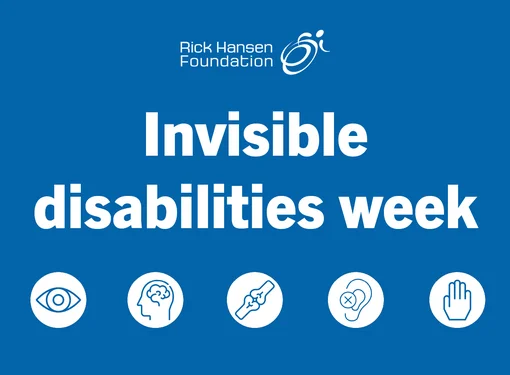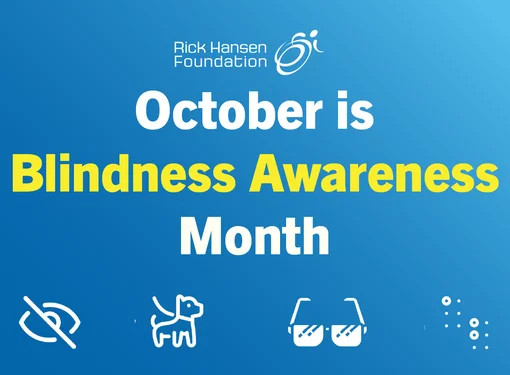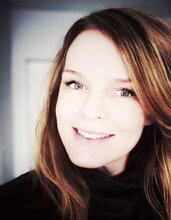Introducing Lui Greco, upcoming panel member at #APN2023: Building Together Presented by Royal Bank of Canada
Lui Greco has a passion for sharing his knowledge about accessibility and inclusion. Lui, who is the Manager of Regulatory Affairs and Atlantic Canada Advocacy for the CNIB, will be a panel member at the #APN2023 Building Together presented by Royal Bank of Canada session called ‘Emerging Research for Navigable Environments and Wayfinding for Low-Vision Users’ alongside scientist Alison Novak and architect Colette Parras. Read on for Lui’s perspective on what to expect from his session and what it’s like to navigate the built environment as someone who is blind.
RHF: What does accessibility and inclusion mean to you?
Lui: As a person with a disability, I want, need, and have a responsibility to contribute to my community. In doing so, I face barriers ranging from transportation to those that exist in the built environment. With minimal or modest effort from those who work in these areas, these barriers can be overcome if society exercises its decision-making ability to do so. Inclusion, well, that’s harder to answer. Yes, someone with a disability can be barred from being included if the places where people gather aren’t accessible. But, in my view, inclusion goes much further than physical access. It’s about the attitudes and ways society welcomes people with different abilities. It’s one thing to say, “we are an inclusive organization,” but it’s quite different to live it.
RHF: What are some of the more problematic barriers you encounter on a daily basis?
Lui: Starting with attitudinal: despite the proliferation of comprehensive awareness-building exercises, it’s as if the public tunes them out. Yes, people are bombarded with a multitude of messages today, and, very likely, it’s a feeling of “that’s nice to know, but it doesn’t affect me ….”. Then, someone like me comes along and asks for guidance or to be accommodated. Every time, regardless of who’s being asked, it’s an educational opportunity. But, I was having these conversations 40 years ago! There are few parts of my life as someone who is blind where I’m not forced to fight the good fight. For example, my home insurance company sends me documents that I can’t read, my investment broker can’t understand why I can’t complete a form, and so on. Taking the bus to a mall to buy a new pair of pants is a journey, especially if I’ve never been to that mall. Sure, I could ask a friend to join me, but that should be an option, not the only means by which I can live my life.
RHF: How can we get people to understand accessibility goes far beyond the idea of wheelchair ramps?
Lui: If I had the answer to this, I’d shout it from the hilltop. I believe people understand common physical barriers because they’re easier to comprehend. It makes sense that you can’t get a wheelchair up a flight of stairs so you’d need a ramp. But, for someone who is blind, it’s the less obvious that creates barriers. Sure, we have mobile navigation apps, but they only take you within 50 feet of an entrance; that may as well be 50 kilometres from a practical perspective. In my humble opinion, the answer is that more people with sight loss and those, like me, who are blind, need to keep asking for reasonable accommodations. Society won’t come up with solutions unless they understand the problem. It’s my job – professionally and in my private world – to keep asking and to push hard when I don’t see progress.
RHF: What is one simple act people can take to encourage accessibility in their communities?
Lui: Let’s all make sure that when public consultations take place, everyone has an opportunity to contribute. For instance, large colour maps are often used. I’m sure they look nice but if you can’t see the map or diagram used during the consultation, you’re left up to the ability and willingness of the facilitator to help you perceive what’s being asked. Everyone needs to ask questions. Never stop asking ‘does what we’re doing work for you?’ And ‘how can we make it better?’ It’s important to remember that those of us who are forced to continually advocate for ourselves or others sometimes get worn down. We can’t let that stop us as education, awareness, and understanding are tools at our disposal. Every time there’s an opportunity to raise the topic of accessibility, it’s all of our jobs to do so.
RHF: Can you tell us what attendees of your upcoming session titled ‘Emerging Research for Navigable Environments and Wayfinding for Low-Vision Users’ at the #APN2023: Building Together conference will learn?
Lui: The main message I hope to convey is that the problem is complex. There is not one easy fix because people, regardless of ability, don’t fit into nice tidy little boxes. What works for me may not work for someone else who is blind. That being said, accessibility and inclusion is not rocket science. Sure, there are some innovative solutions that I’m going to cover in the session, but we’ll also be discussing easy fixes to barriers in the built environment because they can make the biggest impact. I’m looking forward to showing attendees how people with different perceptual abilities navigate public spaces, regardless of their degree of sight loss.

--
The #APN2023: Building Together Presented by Royal Bank of Canada conference has something for everyone. In addition to several interesting sessions about the ins and outs of accessibility, you’ll also learn from speakers such as Michael Gottheil, Accessibility Commissioner to the Canadian Human Rights Commission and Stephanie Cadieux, Canada’s first Chief Accessibility Officer. Learn more and register.







